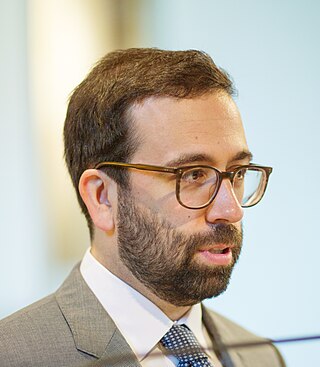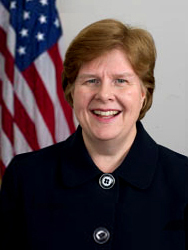Related Research Articles

Macroeconomics is a branch of economics that deals with the performance, structure, behavior, and decision-making of an economy as a whole. This includes national, regional, and global economies. Macroeconomists study topics such as output/GDP and national income, unemployment, price indices and inflation, consumption, saving, investment, energy, international trade, and international finance.
In economics, stagflation is a situation in which the inflation rate is high or increasing, the economic growth rate slows, and unemployment remains steadily high. Stagflation, once thought impossible, poses a dilemma for economic policy, as measures to reduce inflation may exacerbate unemployment.
New Keynesian economics is a school of macroeconomics that strives to provide microeconomic foundations for Keynesian economics. It developed partly as a response to criticisms of Keynesian macroeconomics by adherents of new classical macroeconomics.

Robert Emerson Lucas Jr. was an American economist at the University of Chicago. Widely regarded as the central figure in the development of the new classical approach to macroeconomics, he received the Nobel Memorial Prize in Economic Sciences in 1995 "for having developed and applied the hypothesis of rational expectations, and thereby having transformed macroeconomic analysis and deepened our understanding of economic policy". He was characterized by N. Gregory Mankiw as "the most influential macroeconomist of the last quarter of the 20th century". In 2020, he ranked as the 10th most cited economist in the world.

Nicholas Gregory Mankiw is an American macroeconomist who is currently the Robert M. Beren Professor of Economics at Harvard University. Mankiw is best known in academia for his work on New Keynesian economics.

Ricardo A. M. R. Reis is a Portuguese economist and the A. W. Phillips professor of economics at the London School of Economics. He has published widely on macroeconomics, including both monetary and fiscal policy, inflation and business cycles, and for these he won the 2021 Yrjö Jahnsson Foundation medal awarded every two years by the European Economic Association for best economist under the age of 45. He writes a weekly op-ed for the Portuguese newspaper Expresso.

John Brian Taylor is the Mary and Robert Raymond Professor of Economics at Stanford University, and the George P. Shultz Senior Fellow in Economics at Stanford University's Hoover Institution.

Olivier Jean Blanchard is a French economist and professor. He is serving as the Robert M. Solow Professor Emeritus of Economics at the Massachusetts Institute of Technology and as the C. Fred Bergsten Senior Fellow at the Peterson Institute for International Economics.
Mainstream economics is the body of knowledge, theories, and models of economics, as taught by universities worldwide, that are generally accepted by economists as a basis for discussion. Also known as orthodox economics, it can be contrasted to heterodox economics, which encompasses various schools or approaches that are only accepted by a minority of economists.
Dynamic stochastic general equilibrium modeling is a macroeconomic method which is often employed by monetary and fiscal authorities for policy analysis, explaining historical time-series data, as well as future forecasting purposes. DSGE econometric modelling applies general equilibrium theory and microeconomic principles in a tractable manner to postulate economic phenomena, such as economic growth and business cycles, as well as policy effects and market shocks.
The neoclassical synthesis (NCS), neoclassical–Keynesian synthesis, or just neo-Keynesianism — academic movement and paradigm in economics that worked towards reconciling the macroeconomic thought of John Maynard Keynes in his book The General Theory of Employment, Interest and Money (1936) with neoclassical economics.
New classical macroeconomics, sometimes simply called new classical economics, is a school of thought in macroeconomics that builds its analysis entirely on a neoclassical framework. Specifically, it emphasizes the importance of rigorous foundations based on microeconomics, especially rational expectations.
In economics, the freshwater school comprises US-based macroeconomists who, in the early 1970s, challenged the prevailing consensus in macroeconomics research. A key element of their approach was the argument that macroeconomics had to be dynamic and based on how individuals and institutions interact in markets and make decisions under uncertainty.

Jordi Galí is a Spanish macroeconomist who is regarded as one of the main figures in New Keynesian macroeconomics today. He is currently the director of the Centre de Recerca en Economia Internacional at Universitat Pompeu Fabra and a Research Professor at the Barcelona Graduate School of Economics. After obtaining his doctorate from MIT in 1989 under the supervision of Olivier Blanchard, he held faculty positions at Columbia University and New York University before moving to Barcelona.

Christina Duckworth Romer is the Class of 1957 Garff B. Wilson Professor of Economics at the University of California, Berkeley and a former chair of the Council of Economic Advisers in the Obama administration. She resigned from her role on the Council of Economic Advisers on September 3, 2010.

Macroeconomic theory has its origins in the study of business cycles and monetary theory. In general, early theorists believed monetary factors could not affect real factors such as real output. John Maynard Keynes attacked some of these "classical" theories and produced a general theory that described the whole economy in terms of aggregates rather than individual, microeconomic parts. Attempting to explain unemployment and recessions, he noticed the tendency for people and businesses to hoard cash and avoid investment during a recession. He argued that this invalidated the assumptions of classical economists who thought that markets always clear, leaving no surplus of goods and no willing labor left idle.
In macroeconomic theory, general disequilibrium is a situation in which some or all of the aggregated markets, such as the money market, the goods market, and the labor market, fail to clear because of price rigidities. In the 1960s and 1970s, economists such as Edmond Malinvaud, Robert Barro and Herschel Grossman, Axel Leijonhufvud, Robert Clower, and Jean-Pascal Benassy investigated how economic policy would impact an economy where prices did not adjust quickly to changes in supply and demand. The most notable case occurs when some external factor causes high levels of unemployment in an economy, leading to households consuming less and firms providing less employment, leading to a rationing of both goods and work hours. Studies of general disequilibrium have been considered the "height of the neoclassical synthesis" and an immediate precursor to the new Keynesian economics that followed the decline of the synthesis.
The new neoclassical synthesis (NNS), which is occasionally referred as the New Consensus, is the fusion of the major, modern macroeconomic schools of thought – new classical macroeconomics/real business cycle theory and early New Keynesian economics – into a consensus view on the best way to explain short-run fluctuations in the economy. This new synthesis is analogous to the neoclassical synthesis that combined neoclassical economics with Keynesian macroeconomics. The new synthesis provides the theoretical foundation for much of contemporary mainstream macroeconomics. It is an important part of the theoretical foundation for the work done by the Federal Reserve and many other central banks.

Emi Nakamura is a Canadian-American economist. She is the Chancellor's Professor of Economics at University of California, Berkeley. Nakamura is a research associate and co-director of the Monetary Economics Program of the National Bureau of Economic Research, and a co-editor of the American Economic Review.
Jón Steinsson is Chancellor's Professor of Economics at University of California, Berkeley, a research associate and co-director of the Monetary Economics program of the National Bureau of Economic Research, and associate editor of both American Economic Review: Insights, and the Quarterly Journal of Economics. He received his PhD in economics from Harvard and his AB from Princeton.
References
- ↑ General equilibrium analysis of government financial policies mit.edu
- ↑ "A Study of the Effects of Population on Development, with Applications to Japan". Princeton University Library Catalog. 1998. Retrieved January 25, 2024.
Senior thesis
- ↑ Romer, David (1981). "Rosen and Quandt's Disequilibrium Model of the Labor Market: A Revision". Review of Economics and Statistics. 63 (1): 145–146. doi:10.2307/1924231. JSTOR 1924231.
- ↑ Ball, Laurence; Romer, David (1990). "Real Rigidities and the Non-Neutrality of Money". The Review of Economic Studies. 57 (2): 183. doi:10.2307/2297377. JSTOR 2297377.
- ↑ Romer, Christina D; Romer, David H (2002). "A Rehabilitation of Monetary Policy in the 1950s". American Economic Review. 92 (2): 121–127. doi:10.1257/000282802320189113.
- ↑ Romer, Christina D; Romer, David H (2008). "The FOMC versus the Staff: Where Can Monetary Policymakers Add Value?". American Economic Review. 98 (2): 230–235. doi:10.1257/aer.98.2.230.
- ↑ "Archived copy" (PDF). Archived from the original (PDF) on December 2, 2008. Retrieved November 27, 2008.
{{cite web}}: CS1 maint: archived copy as title (link) - ↑ "Archived copy" (PDF). Archived from the original (PDF) on September 27, 2011. Retrieved September 20, 2011.
{{cite web}}: CS1 maint: archived copy as title (link) - ↑ "David Romer CV" (PDF). econ.berkeley.edu.
- ↑ Greg Garber. "Fourth-down analysis met with skepticism". ESPN. Retrieved January 25, 2024.
- ↑ "The NBER's Recession Dating Procedure".
- ↑ Romer, David (February 19, 2018). Advanced Macroeconomics. McGraw-Hill Education. ISBN 978-1260185218.
- ↑ "Faculty couples keep love alive at work". dailycal.org. Retrieved November 27, 2008.[ dead link ]
- ↑ "Berkeley Couple Tackle Top Fiscal Issues of the Day". Archived from the original on February 15, 2009.
- ↑ Mankiw, Greg (May 30, 2006). "The IS-LM Model" . Retrieved December 30, 2008.
- ↑ Lerer, Lisa (November 26, 2008). "Who is Christina Romer?". Politico.com. Archived from the original on December 2, 2008. Retrieved December 30, 2008.